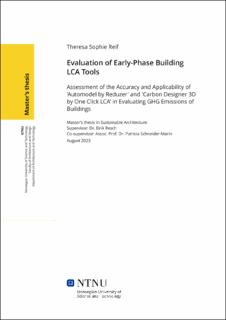| dc.description.abstract | The construction sector contributes significantly to anthropogenic climate change through greenhouse gas (GHG) emissions. Therefore, it is important to reduce operational and embodied emissions from structures. The thesis focuses on the consideration of embodied emissions from building materials. Life Cycle Assessment (LCA) calculation tools enable informed decision-making toward increased sustainability during the design process. The initial design phase of buildings wields significant influence over the buildings’ emissions throughout their lifecycle. However, the lack of information at an early-phase regarding design specifics and their potential impact on emissions presents a challenge for sound guidance. Formulating parametric models as the basis for GHG calculations is an important strategy to fill in knowledge gaps that include design decisions not yet made in the conceptual design phase. This study delves into exploring and assessing the tools ‘Automodel’ by Reduzer and ‘Carbon Designer 3D’ by One Click LCA (OCL) through two case studies. The tools focus exclusively on calculating the material-associated Global Warming Potential (GWP) for the main building and are user-friendly with intuitive interfaces. Supplemented by a comprehensive literature review, this study elaborates on the essential parameters required for a meaningful estimation of early-phase GHG emissions. These are: Generating a simplified model, though representing the complexity of the design appropriately; Developing a complete building model where initially unknown parameters are augmented with assumptions to allow for consistent scope throughout the process; Using predefined standardized component structures with generic data sets; Including sensitivity information about the results. In terms of prediction accuracy, Reduzer's Automodel and OCL's Carbon Designer 3D have the potential to support planning decisions, albeit with limitations in producing accurate predictions of the total GWP. Carbon Designer 3D excels at visualizing designs, while Automodel allows for the creation of complex geometries. However, there is room for improvement in both tools. E.g., Automodel can be improved as follows: More accurate consideration of internal walls; Use of generic material data; Representation of building complexity in one model without requiring multiple versions; Use of checkboxes to query additional design features; Inclusion of uncertainty ranges for calculation results; Optimization of usability through easier component switching and a graphical representation of the parametrically generated model. | |
